If you’ve already walked a long mile in your local SEO shoes, chances are you have plenty of lived experiences that allow you to predict some of the responses to large-scale local business review surveys.
It’s affirming to see, for example, that 85% of our respondents place a degree of trust in local business reviews, and 92% now believe that brands responding to reviews have become part of offering good customer service.
Consumers are also seeking review content across a wide variety of platforms, including traditional local business listings like Google Business Profiles, social media sites like Instagram, and other localized online spaces.
You could have made an educated guess about stats like these, but pay attention to the data in this survey that contains genuine surprises.
Statistics that challenge your biases provide critical learning moments that can feed into your local search marketing strategy.
Unexpected data points can also help you earn buy-in from decision-makers for local SEO initiatives you want to explore.
I’d like to share six local business review findings from our survey of 1,200+ North American consumers that taught me something new, plus one stat I accurately predicted and that I want to be sure is accessible to anyone involved in marketing local brands.
1. Young Consumers Are Surprisingly Patient When It Comes To Owner Responses To Reviews
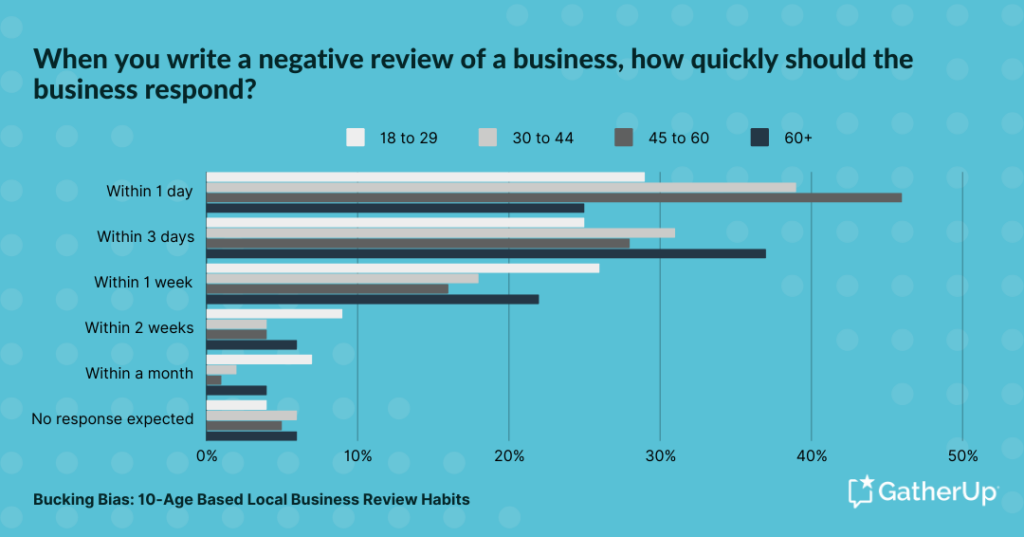 Screenshot from GatherUp, January 2025
Screenshot from GatherUp, January 2025I was genuinely surprised to discover that consumers aged 45 to 60 have the highest expectations when it comes to review response time frames, with 46% of them expecting to hear back from businesses within one day.
I wrongly supposed that our youngest demographic would have the least patience because they have grown up in an era of such intense automation.
Brands that primarily serve youthful consumers are constantly told that all processes must be made as frictionless as possible to avoid abandonment and loss.
Still, this survey question reveals that – at least when it comes to owner responses to reviews – 18- to 29-year-olds are the dominant group that will tolerate reviews taking one or more weeks to receive a reply.
The best practice remains to respond to all incoming reviews as quickly as you possibly can.
If your consumer base is young, there could be other elements of your local search marketing and brand-consumer communications that require more urgent action.
2. Word-Of-Mouth Recommendations Are Far More Trusted Than Reviews
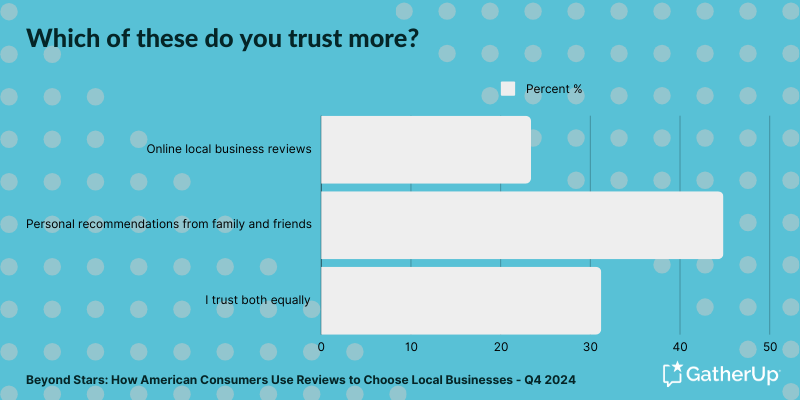 Screenshot from GatherUp, January 2025
Screenshot from GatherUp, January 2025The survey found that just 31% of consumers trust online local business reviews as much as they do personal recommendations from family and friends.
This stat will come as a genuine shocker to anyone who has concluded from other surveys over the past couple of decades that most people trust reviews as much as they do word-of-mouth (WOM) referrals.
It’s vital to know that 45% of your consumer base is likely to rely more trustingly on whether the people they know in real life think your business is worth trying than they do on the sentiment of online strangers.
This finding emphasizes the critical need for customer service standards that inspire consumers to recommend your brand to their circle.
Formal loyalty programs should be strongly considered in your local search marketing strategy.
3. Review Reading Is On The Rise
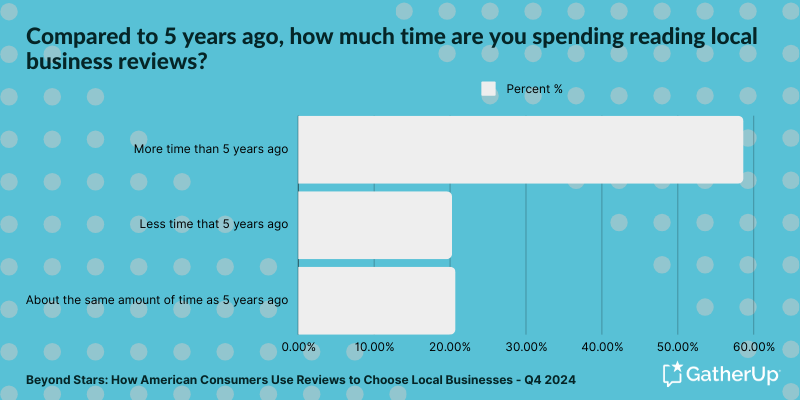 Screenshot from GatherUp, January 2025
Screenshot from GatherUp, January 2025Due to our tech-driven society’s fascination with the latest new thing, I might have thought this survey would yield signs that the review honeymoon could be over.
After all, local business reviews are now more than 20 years old, and the internet is increasingly full of distractions that could supplant the quiet habit of perusing review content.
As it turns out, I couldn’t be more wrong.
A significant 59% of consumers report spending more time reading local business reviews than they did five years ago.
We can theorize about whether this uptrend might be the result of the COVID-19 pandemic causing more dependence on the web, the outrageous cost of remote shipping prompting consumers to search for local alternatives, or other contributing factors.
Whatever the cause, the narrative you need to take to your next local search marketing strategy session is that the value of reviews is on the rise, meaning reputation management deserves priority resources.
It’s important to note that Google continues to invest in highlighting review content, both on Google Business Profiles and in other formats like the bonus text snippets called local justifications that can appear in local packs and Maps. Google clearly thinks that reviews matter.
4. Are Star Ratings Less Important Than You Think?
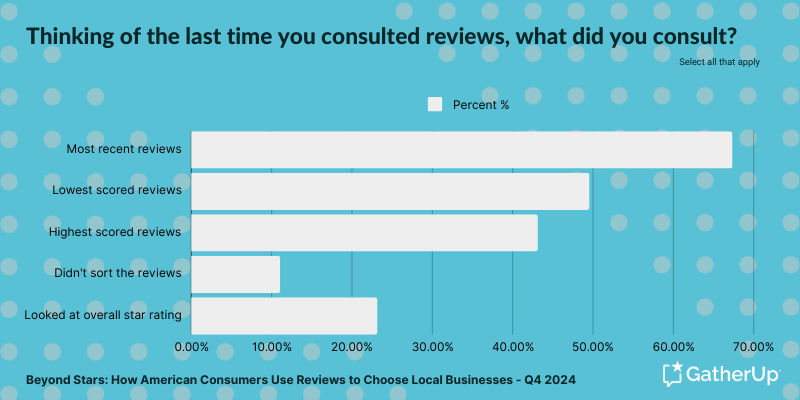 Image from GatherUp, January 2025
Image from GatherUp, January 2025My gut would tell me that the overall star rating of local businesses on listings like Google Business Profiles would be the ultimate factor determining whether a particular business gets chosen by a consumer for a transaction. The data says otherwise.
Just 23% of respondents stated that they looked at the overall star rating of brands the last time they consulted reviews.
This pales in comparison to the 67% who focused on the most recent reviews, and the 50% who prioritized looking at the lowest-star reviews first.
This is a takeaway I find so surprising that it is challenging to construct any other narrative surrounding it than this: Modern consumers have realized that average ratings include all of the reviews a business has ever received, and that this may not be reflective of current quality.
The public is smart if they are trying to find out how fellow consumers feel about a business today, this week, or this month, instead of how a brand has performed historically.
The learning here is obvious: A successful reputation management program is one that delivers a steady stream of fresh, incoming review content.
If your review river is stagnating, you need to find whatever is damming it and remove those obstacles to ensure that your community can quickly access recent sentiment about your brand.
5. Only A Minority Of Review Readers Are Interested In Responses That Detail Brand Improvements
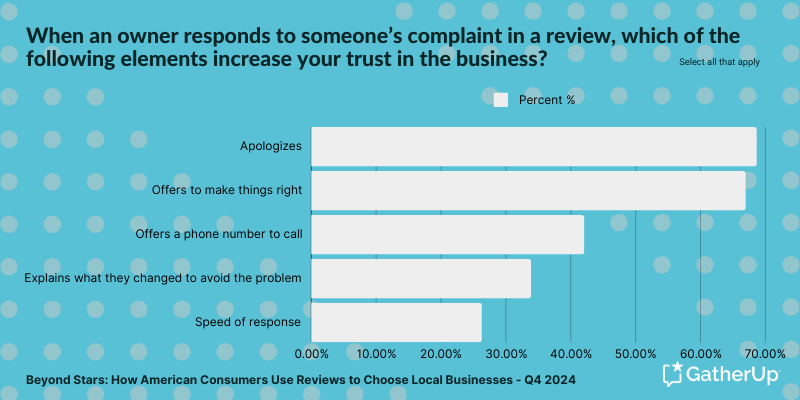 Screenshot from GatherUp, January 2025
Screenshot from GatherUp, January 2025In the past, I’ve recommended local business clients be certain that their owner responses to negative reviews include a detailed explanation of the improvements they’ve made to ensure that other customers don’t experience the same problem the reviewer encountered.
For example, if an unhappy reviewer mentioned that their pizza was delivered cold, I would have typically advised the brand to analyze whether this sentiment about cold food was emergent and uptrending, and then to make an operational fix.
I would have counseled them to respond to all such negative reviews with the information that the business had invested in new insulated carrier bags, or what have you.
Now, seeing that just 34% of review readers highly value this type of explanation, I may alter my best practice advice in a particular use case.
I am frequently asked by large multi-location enterprises about how to prioritize review responses when dealing with hundreds or thousands of incoming reviews.
I have seen some marketers suggest that the business should only respond to negative reviews to make scaling more manageable, but I remain leery of this advice because surveys like this one confirm for me that 73% of consumers appreciate being thanked by the business for their positive feedback.
Instead, if scaling review management is necessitating a shortcut at the moment, you might experiment with limiting the text of your owner responses to negative reviews to a sincere apology and contact information for in-person resolution, rather than taking extra time to describe operational improvements.
6. Instagram Is Definitely In The Local Business Reputation Game
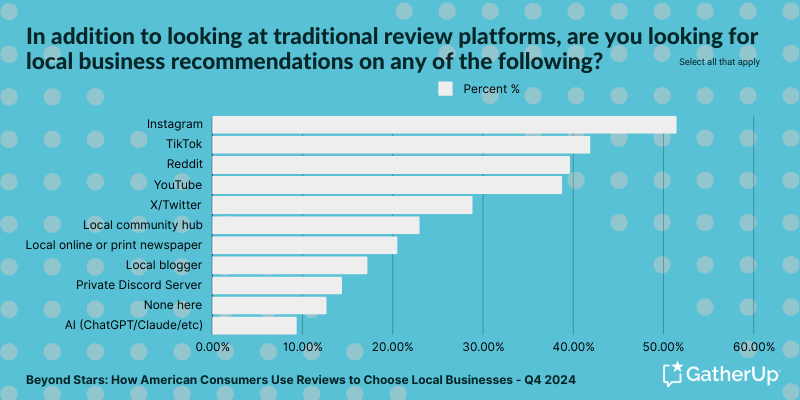 Screenshot from GatherUp, January 2025
Screenshot from GatherUp, January 2025I hear a lot of grief from small business owners about Instagram’s algorithm, and though I use the platform fairly frequently, I find its formatting a bit of a mess.
These are biases on my part that led to my surprise that 52% of modern consumers are relying on this social media space for local business recommendations.
I think YouTube is a more natural fit for local business marketing for most brands, but if there’s one mantra to put at the heart of your company, it’s to be wherever your customers are.
Of course, your vertical comes into play here. Business models that relate to pleasure (think restaurants, bakeries, travel) have an advantage in the Instagram community.
If you are marketing a legal firm or a plumbing franchise, this particular social sphere could be a hard one to make headway in.
My overall takeaway from responses to this question is that a growing number of platforms are influencing local purchasing decisions. It’s not enough to manage your reputation on Google, Yelp, or TripAdvisor.
You need a presence and a fandom on whichever platforms are favored by the towns and cities you serve to maximize the referrals your brand receives around the web.
7. The One Stat I Don’t Want You To Miss!
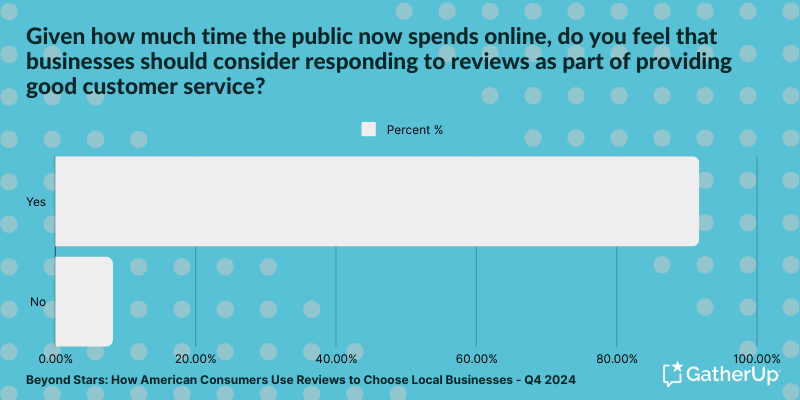 Image from GatherUp, January 2025
Image from GatherUp, January 202592% of consumers now consider owner responses to reviews as part and parcel of providing good customer service.
This is the statistic that did not surprise me, but which I had never seen codified by any other local business review survey.
It confirms for me the advice I’ve been giving small-to-enterprise brands for many years now that creating the best possible online consumer experiences is as crucial to building a strong reputation as what happens within premise walls.
Your customers’ online and offline experiences with your company work in concert to form their opinions and determine whether they will come to you for repeat transactions, recommend you to others, and speak well of you socially.
Given this, timely, professional, accountable owner responses to reviews must be seen as a top-tier activity in your local search marketing strategy.
Few brands are large enough to safely be able to ignore a customer who is trying to communicate with them via a review.
Monopolies and near-monopolies who are getting away with review neglect are also likely leaving profits on the table because, even if a town has only one hardware franchise, fabric store branch, or supermarket, remote fulfillment is now at the fingertips of most consumers, thanks to the internet.
It’s my hope that this statistic will cut through so many of the tantalizing shortcuts to real customer service that are on offer today.
There is no more vital or lucrative focus for local brands of any size than ensuring that they are in a trustworthy, responsive, and reliable relationship with their customer base.
Smart brands will put this at the heart of their marketing strategy.
Summing Up
Surveys matter to the local SEO industry because they both confirm hypotheses and challenge biases, offering the opportunity to base strategy on data instead of guesses.
This useful survey taught me not to undervalue the patience of the youngest consumers and to encourage my clients to earn more WOM recommendations because they are more trusted than online equivalents.
Also, it taught me that online distractions aren’t getting in the way of review reading, fresh review content is more important than ever, shorter responses to negative reviews may be acceptable in some cases, and Instagram needs to be thought of as a dominant player in the local business reputation milieu.
It also confirmed my long-suspected but up-to-now unproven theory that owner responses must be seen as integral to providing good customer service.
If you’re marketing a brand that is not yet bringing its A-game to reputation management, you can share the following tips to help it rapidly improve, based on additional findings of this survey:
- Begin collecting email and SMS contact info at the time of service so that you can request reviews. 83% of your customers will be at least somewhat responsive to your requests for their reviews.
- Train staff to ask for reviews in person at the time of service. 47% of customers prefer this form of request.
- Respond to all incoming reviews in a timely fashion. 73% of consumers appreciate being thanked for positive feedback, and 79% expect your response to their complaints.
- Respond to negative reviews with an apology and an offer to make things right. 73% of unhappy customers will be willing to give your business a second chance if your owner response solves their problems.
- Avoid engaging in any form of review fraud. Only 14% of people will give your business a try if your local business profiles get stamped with a review spam warning.
My final tip: A good large-scale review survey should inspire you to conduct a smaller one of your own within your unique consumer base.
Polling customers on a regular basis is the best way to spot new trends, behaviors, and opportunities. The better you know the preferences and habits of your community, the better prepared you’ll be to serve.
You can read the full survey results here from GatherUp.
More Resources:
- 18 Online Review Statistics Every Marketer Should Know
- New Study Finds That Review Requests Should Be Treated Like Customer Service
- A Guide To Local SEO
Featured Image: Song_about_summer/Shutterstock

![Surprising Review Stats To Feed Your Local Strategy [Study]](https://www.searchenginejournal.com/wp-content/uploads/2025/01/review-stats-981.png)



![[SEO, PPC & Attribution] Unlocking The Power Of Offline Marketing In A Digital World](https://www.searchenginejournal.com/wp-content/uploads/2025/03/sidebar1x-534.png)